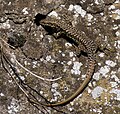Mainz citadel moat
Mainz Citadel Ditch is the common name for the protected landscape component on the grounds of the Mainz Citadel , located in the inner city area, with a size of around 8 hectares. The city of Mainz designated the area as a protected landscape component in 1986 for nature conservation reasons . Its exact designation in the ordinance reads: Green space of the citadel complex with moat area .
Area description
The protected landscape component includes the citadel moat on the southern side of the fortress. Then there are the walls standing there and other areas within the citadel that border the protected walls and the southern citadel moat.
"The flora and fauna that developed over decades on parts of the citadel are of inestimable value today," the city of Mainz assesses the area. Investigations revealed 447 animal and plant species, 66 of which are on the "Red List"; Examples are brown long-eared bat, wall lizard, long-horned beetle, dwarf deer beetle, yew and flaky mullein. The walls are of "nationwide importance" because over 170 species of stinging voices (wild bees, digger wasps) live in their cavities. In addition, these walls with a total area of 19,000 square meters are among the "most important moss biotopes in the country". In addition to the biodiversity, undisturbed habitats have been created in the protected part of the landscape for centuries, which offer special "genetic reservoirs" of the species represented there that are worth protecting. In addition, the protected area represents a "green lung" for the inner city, "which is cut off from fresh air corridors."
Protection purpose
"The protection purpose is the preservation of a very structurally rich, anthropogenic area with its remarkable wall joint biotopes, the preservation of the flora and fauna there (including Red List species ), ensuring the efficiency of the natural balance (improvement of the urban microclimate ) as well as the revitalization, structure and maintenance of the townscape. "
pads
According to the legal ordinance of 1986, all measures that run counter to the protective purpose are prohibited, including a. the use of biocides, the damage to wild plants, any disturbance of animals (dogs must be kept on leash), the erection of new structures, etc. The fact that the protected area is located in the historically significant citadel complex of Mainz, which is a listed building, takes into account the statutory ordinance such as follows: "During the work, care must be taken that the crack and joint structure necessary for the flora and fauna is preserved as far as possible".
controversy
Occasionally there is talk of a "battle between monument protection and nature protection" in relation to the Mainz Citadel, the masonry of which has clearly lost its stability over the centuries in the entire complex. "Without a doubt, this is primarily due to the age of the building." However, it is also undisputed that roots of trees penetrated the previously damaged masonry, which increased the damage. The association Initiative Zitadelle Mainz eV (IZM) complains: "The citadel is falling into disrepair despite monument protection"; the Naturschutzbund Deutschland Mainz und Umgebung eV (NABU) would like to receive the "green gem in the city" and points out that vegetation z. T. also protected walls from weathering.
Between 2006 and 2008, an "ecological wall renovation" test was carried out on a sub-segment of the wall in a pilot project funded by the DBU . In 2015, NABU took over the maintenance of some areas in the citadel moat from the city. In February 2017, the Mainz Environment and Construction Department heads, together with NABU and IZM, announced an agreement on how monument protection and nature conservation should be brought together: 128 trees of the 2550 trees in the complex are to be felled that endanger the walls. To compensate for this, new plantings are planned on a sports field, which at the time still existed on the site of the citadel ditch. The most important measure is the laying of paths with the aim of creating a place of retreat for animals and plants that is undisturbed by walkers. Minimum distances from trees to walls are observed.
photos
Herbaceous plants like the Gundermann do not damage the historic walls and make the complex an unusual habitat.
literature
Ordinance on the protected landscape component "Green structure of the citadel complex with moat area, district Mainz dated January 10, 1986 accessed on May 14, 2017
Web links
- State capital Mainz: The citadel moat as a "protected landscape component" accessed on May 14, 2017
- Photo documentation of the citadel moat of the Local Agenda (2016) accessed on May 14, 2017
Individual evidence
- ↑ a b c State capital Mainz: The green of the Mainz Citadel , accessed on May 14, 2017.
- ↑ a b Ordinance on the protected landscape component "Green area of the citadel complex with moat area", Mainz district of January 10, 1986 , accessed on May 14, 2017
- ↑ Hartmut Raible: Monument Protection & Nature Protection. In: Stefan Schmitz (ed.): Mainz. The citadel on the Jakobsberg. A cultural monument on the move. Mainz 2017, page 56
- ↑ Citadel Mainz EV initiative: The citadel is falling apart - despite monument protection, accessed on May 14, 2017
- ↑ NABU Mainz and the surrounding area: A green gem in the middle of the city , accessed on May 14, 2017.
- ↑ Merkurist Mainz: NABU takes over in the citadel ditch , accessed on May 14, 2017.
- ↑ Allgemeine Zeitung: Zitadelle Mainz: Now it depends on the money from February 16, 2017, accessed on May 14, 2017
Coordinates: 49 ° 59 ′ 30 ″ N , 8 ° 16 ′ 30.3 ″ E















